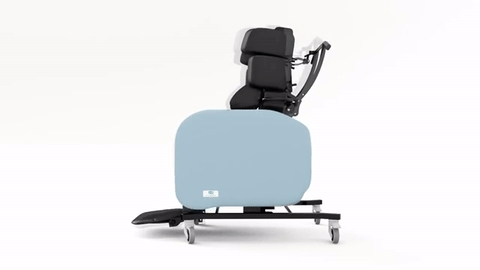
When is Back Angle Recline Used?
Great question. Back angle recline can be used for comfort and to redistribute pressure. It is crucial that the back angle of the chair matches the hip angle of the client to prevent them from falling into an improper seating position. If the back angle does not match the hip angle, the client might slide from the chair, which could cause sacral sitting or a Posterior Pelvic Tilt. Guidelines recommend that seated individuals be re-positioned every 2 hours to redistribute pressure and off load high pressure areas.
Recline on its own can cause sliding from a chair for clients that have poor postural control, thus increasing shear and friction. It is recommended that Tilt in Space is used in conjunction with Recline for this group of clients.
As a rule of thumb, I never recommend a recline-only chair for clients who are unstable and have poor postural control.
Re-positioning can be accomplished by an adjustment in the angle of the back of the chair. In patients with limited hip flexion, the angle of recline can be locked at an optimum angle position to reduce the risk of sliding and improve comfort.
Which Chairs Facilitate Back Angle Recline?
The Seating Matters Phoenix™, Sorrento™, Bariatric Sorrento™ Atlanta™, Milano™ and Monaco™ chairs all have back angle recline adjustment. This feature can be temporarily locked at a specific angle, depending on the patient’s needs. This will limit improper adjustment and allow for easy adjustment as required.
To find out more about back angle recline click here.
Tilt in space is when the entire chair tilts on its frame, whilst the angle of the patient’s hips, knees and ankles remain the same.

When is Tilt in Space Used?
Tilt in space redistributes pressure to off load the Ischial Tuberosities (IT’s). Tilting the client back whilst maintaining the angles in their hips, knees and feet creates a safe position for the client. Redistributing weight through their back reduces potential pressure ulcers, whilst creating a comfortable, stable and functional position for the user.
Which Chairs Facilitate This Feature?
The optimum angle for improving positioning and function is 15-30° which comes as standard on our Phoenix™, Sorrento™, Milano™ and Bariatric Sorrento™ chairs.
A 45° tilt is needed for patients who are at a greater risk of pressure ulcers and proves an effective angle for weight shift and pressure management.
The Seating Matters Sorrento™ and Phoenix™ chairs have the option of increased tilt in space to a maximum of 45° with built-in back recline adjustment.
Click here to dive deeper into the use of tilt in space.
Remember we have free resources on hand to help you in prescribing correct seating for your patient or loved one. It is important to note, that the misuse of either of these features can injure a user, a caregiver, cause unwanted side-effects. If you are new to healthcare seating, we recommend:
- A Free Seating Assessments. These assessments are carried out by your local Seating Specialist to determine how therapeutic seating can meet your care needs and advise on best practices for the use of tilt in space and recline.
- Speaking to our Internal Seating Specialists. Trained by me and available to answer your questions at any time. Please contact us by phone, email or using the live chat feature on your browser.
** This post was originally published on http://blog.seatingmatters.com/faq-what-is-the-difference-in-recline-and-tilt-in-space


